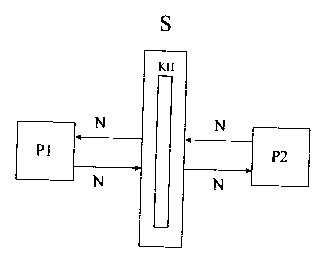Une partie des informations de ce site Web a été fournie par des sources externes. Le gouvernement du Canada n'assume aucune responsabilité concernant la précision, l'actualité ou la fiabilité des informations fournies par les sources externes. Les utilisateurs qui désirent employer cette information devraient consulter directement la source des informations. Le contenu fourni par les sources externes n'est pas assujetti aux exigences sur les langues officielles, la protection des renseignements personnels et l'accessibilité.
L'apparition de différences dans le texte et l'image des Revendications et de l'Abrégé dépend du moment auquel le document est publié. Les textes des Revendications et de l'Abrégé sont affichés :
| (12) Demande de brevet: | (11) CA 2340708 |
|---|---|
| (54) Titre français: | PROCEDE DE CONVERSION DE FORMATS DE DONNEES DIFFERENTS |
| (54) Titre anglais: | METHOD FOR CONVERTING DIFFERENT DATA FORMATS |
| Statut: | Réputée abandonnée et au-delà du délai pour le rétablissement - en attente de la réponse à l’avis de communication rejetée |
| (51) Classification internationale des brevets (CIB): |
|
|---|---|
| (72) Inventeurs : |
|
| (73) Titulaires : |
|
| (71) Demandeurs : |
|
| (74) Agent: | SMART & BIGGAR LP |
| (74) Co-agent: | |
| (45) Délivré: | |
| (86) Date de dépôt PCT: | 1999-08-17 |
| (87) Mise à la disponibilité du public: | 2000-03-02 |
| Licence disponible: | S.O. |
| Cédé au domaine public: | S.O. |
| (25) Langue des documents déposés: | Anglais |
| Traité de coopération en matière de brevets (PCT): | Oui |
|---|---|
| (86) Numéro de la demande PCT: | PCT/DE1999/002575 |
| (87) Numéro de publication internationale PCT: | WO 2000011560 |
| (85) Entrée nationale: | 2001-02-15 |
| (30) Données de priorité de la demande: | ||||||
|---|---|---|---|---|---|---|
|
Les systèmes multiprocesseurs actuels tels que par ex. les systèmes de communication sont en règle générale équipés de processeurs qui traitent des formats de données divers. Des informations qui sont échangées entre des processeurs de ce type doivent donc être soumises à une conversion de format. Dans l'état actuel de la technique, des interventions importantes dans le compilateur ou un format de données standardisé dans l'interface (par ex. ASN.1) sont nécessaires à cet effet. Selon la présente invention, une procédure plus efficace est obtenue grâce à la présence d'un outil à l'aide duquel une procédure de conversion est introduite automatiquement dans l'interface logicielle entre les processeurs.
Current multi-processor systems, such as communication systems, are generally
provided with processors for processing various data formats. The information
exchanged between such processors must therefore be submitted to a format
conversion. The state-of-the-art techniques involve heavy operations in the
compiler or a standardised data format in the interface (e.g. ASN.1) in order
to reach this goal. The present invention provides a more efficient method
that involves using a tool for automatically introducing a conversion process
in the software interface between the processors.
Note : Les revendications sont présentées dans la langue officielle dans laquelle elles ont été soumises.
Note : Les descriptions sont présentées dans la langue officielle dans laquelle elles ont été soumises.

2024-08-01 : Dans le cadre de la transition vers les Brevets de nouvelle génération (BNG), la base de données sur les brevets canadiens (BDBC) contient désormais un Historique d'événement plus détaillé, qui reproduit le Journal des événements de notre nouvelle solution interne.
Veuillez noter que les événements débutant par « Inactive : » se réfèrent à des événements qui ne sont plus utilisés dans notre nouvelle solution interne.
Pour une meilleure compréhension de l'état de la demande ou brevet qui figure sur cette page, la rubrique Mise en garde , et les descriptions de Brevet , Historique d'événement , Taxes périodiques et Historique des paiements devraient être consultées.
| Description | Date |
|---|---|
| Inactive : CIB expirée | 2019-01-01 |
| Inactive : CIB expirée | 2018-01-01 |
| Inactive : CIB de MCD | 2006-03-12 |
| Demande non rétablie avant l'échéance | 2003-08-18 |
| Le délai pour l'annulation est expiré | 2003-08-18 |
| Réputée abandonnée - omission de répondre à un avis sur les taxes pour le maintien en état | 2002-08-19 |
| Inactive : Page couverture publiée | 2001-05-15 |
| Inactive : CIB en 1re position | 2001-05-13 |
| Lettre envoyée | 2001-04-20 |
| Lettre envoyée | 2001-04-20 |
| Inactive : Notice - Entrée phase nat. - Pas de RE | 2001-04-20 |
| Demande reçue - PCT | 2001-04-14 |
| Demande publiée (accessible au public) | 2000-03-02 |
| Date d'abandonnement | Raison | Date de rétablissement |
|---|---|---|
| 2002-08-19 |
Le dernier paiement a été reçu le 2001-07-12
Avis : Si le paiement en totalité n'a pas été reçu au plus tard à la date indiquée, une taxe supplémentaire peut être imposée, soit une des taxes suivantes :
Veuillez vous référer à la page web des taxes sur les brevets de l'OPIC pour voir tous les montants actuels des taxes.
| Type de taxes | Anniversaire | Échéance | Date payée |
|---|---|---|---|
| Enregistrement d'un document | 2001-02-15 | ||
| Taxe nationale de base - générale | 2001-02-15 | ||
| TM (demande, 2e anniv.) - générale | 02 | 2001-08-17 | 2001-07-12 |
Les titulaires actuels et antérieures au dossier sont affichés en ordre alphabétique.
| Titulaires actuels au dossier |
|---|
| SIEMENS AKTIENGESELLSCHAFT |
| Titulaires antérieures au dossier |
|---|
| ANDREAS BUCHELT |
| RUDOLF HUBER |
| ULRICH KLEBER |
| WALTER MAYER |